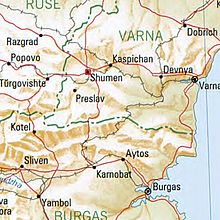Shumen
| Shumen (Шумен) | |||
|
|||
| Basic data | |||
|---|---|---|---|
| State : |
|
||
| Oblast : | Shumen | ||
| Residents : | 89,866 (2013) | ||
| Coordinates : | 43 ° 17 ' N , 26 ° 56' E | ||
| Height : | 184 m | ||
| Postal code : | 9700 | ||
| Telephone code : | (+359) 054 | ||
| License plate : | H | ||
| administration | |||
| Mayor : | Krasimir Kostov | ||
| Website : | www.shumen.bg | ||

Shumen [ ˈʃumɛn ], Bulgarian Шумен Šumen , outdated German Shumla, is a city in eastern Bulgaria . From 1950 to 1965 the name of the city was Kolarowgrad.
Geographical location
Shumen is located on the eastern slope of the Shumen Plateau , surrounded on three sides by mountains, an average of 184 meters above sea level .
history

Shumen is only a few kilometers from the first two capitals of the first Bulgarian empire , Pliska (681-893) and Preslaw (893-982), and the rider of Madara . A memorial was erected in Shumen in 1981 to mark the 1300th anniversary of Bulgaria's existence .
Three kilometers west of what is now Shumen, at the height of Hisarlak, on the Shumen Plateau, lies the old city, above which the 1,500-year-old Shumen fortress is located.
In 1387 Ottoman troops under Sultan Murad I were able to take the city from the Bulgarians. However, archaeological finds show that the city was not destroyed, which suggests a peaceful handover.
After their storming in 1444 under the Polish King Władysław III. Warneńczyk (1424–1444) the town was burned down and abandoned. The town was later rebuilt at its current location in Tal. In the following centuries of Ottoman rule, Shumen was the seat of a strong garrison and a major part of the Ottoman fortress quadrangle Shumen- Russian - Silistra- Warna with a multi-ethnic population.
In 1828 the first girls ' convent school and in 1856 the first secular girls' school was opened in Shumen. In 1850 the first Bulgarian symphony orchestra was founded in the city .
1849-1851 lived here Hungarian freedom fighter Lajos Kossuth (1802-1894) Hungarian with about 2,000 and Polish patriots in emigration . The city was liberated in the Ottoman-Russian War (1877–1878) and incorporated into the Principality of Bulgaria after the Peace of San Stefano . In the period that followed, part of the city's Turkish and Muslim population emigrated.
The city has given its name to Shumen Peak , a mountain on Livingston Island in Antarctica , since 2002 .
Culture and sights
The Tombul Mosque from 1745, as the largest mosque in Bulgaria and one of the largest mosques in the entire Balkans, is well worth seeing . The Tombul Mosque was built in the 18th century using stone blocks from the nearby, early medieval historical town of Pliska , which was the capital of the First Bulgarian Empire between 679 and 893 . The ruins of Pliska were used as a quarry for the Ottoman construction projects, especially in Shumen and Varna. Furthermore, the clock tower from 1740 and the bazaar from the 16th century as well as the forest park near the city and, on the top, the impressive, extensive excavation area of the old city with walls, citadel , three-aisled basilica and other things.
The city is the birthplace of Panayot Wolow (1847-1876) and other representatives of the Bulgarian rebirth, as well as of Vasil Kolarow (1877-1950), a close colleague of Georgi Dimitrov (1882-1949). In their honor, busts have been erected in the city.
- House-Museum Dobri Wojnikow
Economy and Infrastructure
Shumen is an industrial city (truck construction, chemical, aluminum, textile, food and luxury goods industries), an educational center with universities and libraries, and a traffic junction (road and rail).
sons and daughters of the town
- Dobri Wojnikow (1833–1878), writer and theater director
- Kliment Turnowski (1838–1901), Orthodox archbishop, writer and politician
- Panayot Wolow (1850–1876), freedom fighter
- Yusuf İsmail (1857–1898), Turkish wrestler
- Stojan Danew (1858–1949), politician and Prime Minister of Bulgaria
- Janko Sakasow (1860–1941), politician
- Wassil Kolarow (1877–1950), communist leader
- Ahmet Fikri Tüzer (1878–1942), Turkish statesman
- Bojan Penew (1882–1927), literary historian and critic
- Pantscho Wladigerow (1899–1978), composer and pianist
- Wesselin Stojanow (1902–1969), composer
- Lyuben Wassilew (1911–1971), lawyer
- Todor Kolew (1939-2013), actor
- Şevket Candar (* 1966), Turkish football player and coach
- Ivan Ivanov (* 1971), weightlifter
literature
- The city of Shumla . In: The Gazebo . Issue 51, 1853, pp. 568 ( full text [ Wikisource ]).
Web links
Individual evidence
- ↑ Shumen. Frendy.de
- ↑ citypopulation.de

